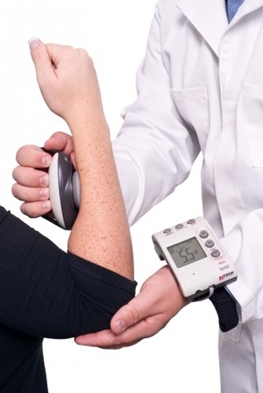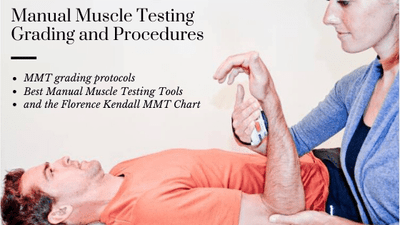 30th Apr 2021
30th Apr 2021
Manual Muscle Testing Grading and Procedures
Manual muscle testing is used in rehabilitation and recovery to evaluate contractile units, including muscles and tendons, and their ability to generate forces. When used as part of rehabilitation, muscle testing is an important evaluative tool to assess impairments and deficits in muscle performance, including strength, power, or endurance.
Impairments in muscle function may result from a number of issues, including:
- Musculoskeletal injuries
- Joint mobilization for extended period of time
- Inactivity
- Neuromuscular disease or disorders
Identifying impairment in specific muscles or muscle groups is an important part in determining the course of rehabilitation which may include therapeutic exercise, manual therapy, bracing, or functional movement training.

What is Manual Muscle Testing?
Manual Muscle Testing(MMT) is a method diagnostic evaluation used by physical therapists, chiropractors, physiological researchers and others concerned with establishing effective treatment and tracking progress throughout a specific regimen. The evolution of current methods of manual muscle testing can be traced back to the early 1900s, when gravity tests were used to assess spinal nerve damage. Modern methods for doing physiological testing have adopted standard accepted procedures and grading systems that allow physicians to understand and communicate muscle testing findings.
Muscle testing can be performed using manual strength testing, functional tests, and dynamometry. Manual muscle strength testing is one of the most commonly used form of muscle testing by practitioners. With MMT, the patient is instructed to hold the corresponding limb or appropriate body part to be tested at a specific point in its available range of motion, working against gravity or while the practitioner provides opposing manual resistance to determine the grade to assign the muscle.
See Available Hand Held Dynamometers For Sale
MMT is such an important part of a physical therapy examination and grading strength an invaluable skill that when performed appropriately can provide the rehabilitation practitioner necessary information which can assist him or her in planning appropriate interventions, modifications, or treatments. There are specific protocols to use when doing MMT to ensure accurate results.
Protocols for Accurate Manual Muscle Testing Results
These protocols are necessary to get the most accurate results with manual muscle testing. Conversely, there are some things to avoid which can negatively impact results.
What to Avoid When Performing Manual Muscle Testing
Here are some of the other things that you should consider when performing manual muscle testing:
- Avoid doing jerking movements when applying resistance to your patient’s during testing
- Discontinue testing if patient complains of pain or discomfort
- Do not leave patient unattended
In 1993, Florence Kendall and two other authors published a guide to performing muscle testing: Muscles: Testing and Function. Detailed below, published by the National Institute of Health is an adaptation from the discussion of muscle testing procedures found in that book, which established a widely accepted grading chart that can be used by physicians to assess patients.
MMT Procedures Chart | Florence Kendall Manual Muscle Testing Chart
How to Grade Muscle Strength Through Manual Muscle Testing
-
Grade 5 (Normal)
-
Grade 4 (Good)
-
Grade 3+ (Fair)
-
Grade 2+ (Poor)
-
Grade 1 (Trace)
-
Grade 0 (Zero)
Grade 5 (Normal) : This grade means the patient is able to complete the full range of motion (movement) against gravity while the practitioner applies maximum resistance.
Grade 4 (Good) : This grade means the patient is able to complete the full range of motion (movement) against gravity while the practitioner applies moderate resistance.
Note: Don’t forget to consider both sides to evaluate whether you are applying adequate force on the limb being tested.
Grade 3 (Fair) : The patient can complete the motion against gravity with no resistance applied by the practitioner. When conducting manual muscle testing this is the level in which the testing begins. If the patient is able to perform at this level, then move on to test for grade 4. If not able to complete this level of testing, then evaluate for grade 2 or lower.
Grade 2 (Poor) : This grade is given when a patient is able to only move through 50% of motion or less in an anti-gravity position (same position as grade 3) or is able to hold position against resistance in a position without gravity.
Grade 1 (Trace) : This grade indicates that no visible movement of the tested body part is detected, but a slight contraction can be palpated.
Grade 0 (Zero) : This grade is given when the patient displays not visible movement or palpable muscle contraction.
Best Manual Muscle Testing Tools
While manual muscle testing is an essential component in rehabilitation, it can have its downsides. For example, testing results may be hampered by a practitioner’s ability to provide adequate resistance. Isokinetic dynamometry uses a measurement device, like a handheld dynamometer, to evaluate the force of the patient’s contraction of a particular muscle group.
These types of muscle strength measurement devices increase efficiency because they are able to apply maximal resistance at all points in the body part’s range of motion at a specified speed, while being able to objectively assess strength, power and endurance.
These tests offer a more complete picture for rehabilitation purposes. In order to look at peak torques; strength is assessed using a slower velocity. Power is assessed using a fast velocity setting to look at the amount of force performed during a specified amount of time. When testing for endurance, the practitioner assesses the patient’s ability to maintain force output during several repetitions during higher velocities.
Related Article : Handheld Dynamometer Buying Guide
Advantages of isokinetic testing include the ability to maximally load the muscle throughout its range of motion; stabilization of proximal body parts to prevent substitute motions; measurement of concentric and eccentric loading; and objectivity. As in manual muscle testing, however, isokinetic testing does not necessarily provide an accurate picture of how a muscle will function during actual activities of daily living or sports. In addition, unlike manual muscle testing, it requires specific equipment. The advantages of hand-help and grip dynamometers include:
- Greater accuracy and validity through objectivity
- Projects a professional image
- No skin-to-skin contact when testing
- Small, compact design so is easily transportable and stored
- Comes with an easy-to-read digital display
Today’s Manual Muscle Testing Techniques have benefitted from advances in technology that have led to the development of measurement devices such as the JTech Commander Echo Muscle Testing Dynamometer.






